Ah, time!
Yes, yet another in the series of things I do which eat up far too much time, effort and energy. Or, alternatively, where my time goes to when I'm not paying attention.
If you have any attention on what I've been saying over the past few years it is that one does not do by writing, marching, or screaming through a megaphone, although that can express certain opinions, of course, but by doing. Thus if you see hard economic times you can do a few things ahead of time to prepare for them. The staples of food, guns and ammo work very well, and if you have decent amounts of ready cash to convert into something hard, like gold or silver, go for it! What this leaves out, however, is that man is made by what he makes and that the ability to do for oneself without relying on others allows you leeway and freedom of action. That is the heart of self-reliance: the DIY attitude.
Thus if you have some of the basics on hand but don't see gold as an option for various reasons, then is there an alternative?
I think so, and the lesson is from that of the Great Depression: be prepared to make some of the things that you can no longer get pre-made by applying your energy, liberty and freedom to such tasks. To do that, however, requires that you actually have the tools necessary to do such work. Thus there is another hard category that is little recognized in the preparation realm, but is as important as gold: tools.
Tools are a source of what makes us human, and even fire is a tool used to keep the night at bay, warm us by its heat and cook our food. With fire we make more tools, like fire-hardened spear and arrow tips with which to hunt. Something that allows you to make something else is a tool, thus fire is a tool. Going beyond fire is hand tools, those that with a bit of sweat you can work with. Hand tools need no electricity, no boiler and no other power source than your ready body and skilled hands, plus a sharp eye on what you are doing. During the Great Depression the stories of those who worked on electronics, fixed things up and made such things as cabinets and shelves at home tell a story of an attitude of not allowing the ebb and flow of economics to dictate your options to you. In the space around you that you can secure, tools then give you exercise of liberty that is beholden only to your own requirements and skill, or lack thereof. To be free, independent and self-reliant you must be able to use tools. Thusly tools are as precious as gold as they are the source of how we get gold, beyond picking it by hand out of stream beds.
Gold is a one-time trade good: you trade it for necessities and then it is gone.
Tools continue to give back by the force of your energy and your liberty put to good use.
Tools allow you to make things to trade with, be it gold or food or making your own guns and ammo.
To this end I've been busy and while my physical health is not what I would call close to 'good' I do have enough waking hours and energy to accomplish a little at a time.
Now, my background is that I went through the normal shop classes in school, but also had a father who was the son of a master woodworker and an electrical and mechanical engineer in his own right. I got to help around his workshop, learn my way around some basic car repair and maintenance, and do a few other odds and ends around the house to put in new phone jacks and such. Thus I don't have deep skills in any single area, and my areas of ignorance are vast. Yet the basics of a hand saw, drill, radial arm saw, rasps, files, nails, screws, sealer, primer, main coat, gloss coat, and how to make sure you stayed safe using all that stuff are things that stick with you throughout life. To get some basic projects done I needed tools, and the tools that are available today in the realm of electrically powered tools are vast and far beyond what was available when I was growing up. This means I must learn by doing.
Now for a few pictures of the shop I'm putting together, with some commentary.
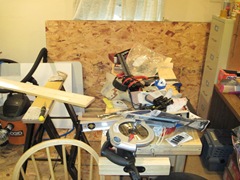
As I walk into the shop area in the basement (we have no garage, so the basement must serve) this is what greets you: work in progress. Most of my tools and workplace supplies comes from Harbor Freight which has been described as 'tools good enough for a work site, but not good enough to steal' by one building contractor I ran across as I was looking for places with cheap tools. I have gotten tools from a number of distributors, some of the 'we just got it off the ship from China and we send it out to you' sort of deals. For my needs cheap and/or sleazy is good enough to work with, and places like SLG Tools, Rafael's Wholesale, Wholesale Tool and DP & Co. have served as places for me to get cut-rate prices on tools necessary to get things stood up.
The workbench, hidden from sight under all the detritus, is a nice one that allows for manual work to be done at a comfortable height. It has drawers, an end vice, and some 5/8" holes for putting pegs to hold work. I've done planing, sanding and a variety of other tasks on it, but those were for small projects. I have a larger one going on and it is in the power tool phase, so the workbench collects the gloves, hat, respirator, hearing protection, clamps, files and all sorts of other things that are needed for addressing minor issues. The circular saw at the end is a HF one, but its arbor bolt cannot come out for love nor money. I contacted the company and they will be sending me a new saw, and this one I get to play with to see if I can free the arbor and save parts of the unit.
My father's workbench was knocked together out of 4x4's, 2x6's and some sort of really thick wooden top, and was square. He had put in a front vice for woodwork and that is something I will look to do with this bench if I ever get some time for it. The workbench is way too nice for my needs, but when I tried ordering normal 5/8" parts from the major manufacturer of bench dogs, I found that they are just a tad too big for the holes. So a bit of filing them to get the sturdier dogs to fit is necessary, and the ones that came with the table are now loose fitting. Such is life.
Notice wood storage along the back wall. I have no other place to put it, so there it must go.
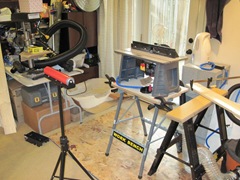
That is a router and table from Lowe's in the more or less center of the picture, on a HF stand with air ducting and adapters for hoods, vents and such mainly coming from Peach Tree and Penn State Industries. Until a couple of months ago I had never thought of a router for something other than the type used for computers (which routes signals on a network). If you have ever wondered how the wainscoting or baseboard gets a uniform profile, the answer is: it is routered in. A router is much like a drill save that it can take lateral strain on its collet, and it utilizes pre-made bits with cutting edges that come in all sorts of lovely shapes and sizes. If you have ever seen dovetailed woodwork or tongue-and-groove woodwork, you can use a router to make those profiles to join wood pieces together. My father used a radial arm saw, drill, hand saws, planes and ingenuity to do the work of a router. For any basic woodworking a hand held router (which is what is under the router table) will do this, and you can get set depth profiles or plunging ones depending on the router and your skill with it. My skill is zero, but I've used it successfully for doing some edging work plus joinery necessary to make quick knock together frames. If you need to make an even slot, even profile or any other continuous feature in wood (there are metal routers available, too) then you need a router.
This one from Lowe's is not high class, and pretty much at the low end of the mid range for 1/4" collet routers. Slow and steady feeding of material is necessary and learning to use the fence, understand the depth of cut and such is somewhat a trial and error deal. I've picked up router bits from all over, including Magnate, Tool King, and Oak Park Enterprises. The cut-rate 'Get X bits in a pre-made package' has, generally, not been worth it, and it is better to get the bits you need rather than a low cost, sometimes low quality assortment from off-off-off brands you have never heard of before in your life. One good glue joinery bit, to me, is worth its weight in gold as it allows for precise cuts that then fit snugly together to give glue lots of surface area to work with. Slotting bits are like miniature circular saw blades, and I have ones that have 3 teeth, although 2 and 4 tooth ones are available for the router. The first time I slotted a board... I had to re-adjust the collet and really snug the thing in there as it was climbing... then the second time I used it I got a lovely set width, set depth cut along 35" of board. I've used some pieces that have other purposes (like make salad bowls) to serve as a miniature contoured plane for fitting pieces into screen window tracks. I don't know how I would have done this stuff without a router.
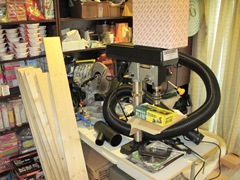
As I can't keep everything set up at one time, I must cycle through tools from a storage table, and this is it. At front is a drill press from HF, which is a 1/2" collet 12 speed affair just good enough to slowly drill metal with good drill bits. No shop should be without one, although my father did all his drilling by hand and eye. Behind that is a small, single room air handler with hose and hood tucked back there for days I'm using the 10" Compound Sliding Arm Miter Saw. That was from HF and the only minor problem with it was that any other blade than the original would rub just a bit on the guard housing. Switching the arbor plates fixed that and it is good to go. Like the radial arm saw, the miter saw kicks up a ton of dust. I'm pretty sure that the actual dust exhaust only gets about 10% of it. A big plastic bag taped behind it and on the top of the slide mount catches a fair amount of it. The rest I have to use the shop vacuum on it.
I've had to make way on the sewing front and the shelf directly behind the table used to be one for my sewing supplies. Most of those are still there, but other stuff has infiltrated as hard goods now take priority over soft ones.
Not seen behind this stuff is a supply cabinet that holds a lot of the other hand tools like angle grinder, jigsaw, and hand power drill, plus rotary tool for dremel-like work. Also some finishing supplies are there, along with my gun maintenance equipment, and a few hand saws. A nice double-sided Japanese hand saw for straight, flat cuts is a miracle and should be a part of anyone's woodworking shop. And its pretty near sharp enough to use as a Samurai weapon, but too flexible in that realm for practical use.
Hidden under the table are fittings for the air handler and shop vac, hose, and a power hand planer to help augment the manual one on top. Also more fabric is under there. Sitting on top of the drill press is a hand power sander, still in its box.
Notice the saw blades: they are for the circular saw. I have a separate place for the 10" blades for the miter saw.
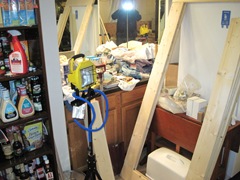
What happens to a wet bar in a shop? It becomes the storage and wash up area for some supplies and equipment. If it needs water then it probably takes a rest on the counter for awhile. Also sitting there are some jars of shellac, hand cleaners and an ultrasonic cleaner. If you need to clean metal or glass (or glasses) then there is nothing better than an ultrasonic cleaner. Great for doing gun work, and if you keep a separate tray of lubricant amenable to ultrasonic work, you can not only clean all the junk off, but then get lubricant in all the crevices, too. It does a fantastic job with just a mild soap solution and glasses, too. Its hidden amongst the junk, but when I need to clean something to get off encrusted dirt, grime or carbon deposits, that is what I turn to.
The gate-leg table on the right has in-process supplies queued up for my project after Step 1 is complete. That and a few other odds'n'ends that wandered over their on their own to get placed handily out of the way. Below that is the sewing machine in its case. Parts of Step 1 are seen in various stages of in-process work after the first couple of phases.
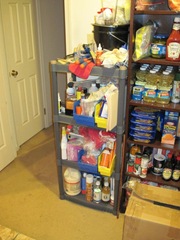
Going completely around the room gets back to the entrance and the storage shelving from Wallyworld that holds all the consumables for woodworking: solvents, glues, putty, mixing sticks and the such. Also there are my solvents and lubricants for gun work, and anything else that can't easily be put somewhere else. Amazing how fast that stuff piles up when you aren't looking.
I've picked up supplies from a large number of places, like Merit Industries and Woodworker's Supply, plus the local Home Depot, Lowe's, Target (pronounced Tarjay)... I don't have much of a running list beyond what I have on the sidebar. I pick up stuff from all over as I can't get out much getting it delivered is often the only way I can get materials in.
Now for a look back across the pseudo-shop.

This gets a somewhat better idea of the space I have to work with and what gets stowed here. That trash can under the rolls of foam is used to get cosmoline from old stocks or other equipment, and is used to warm up any parts that need warming. It goes outside for that work, but it must be stowed someplace.
Do notice that my flooring is carpeted which required a couple of sheets of plywood to get me a firm floor. Ok, semi-firm, but better than carpeting. I don't have the time nor energy to re-do the basement and make a proper shop. If the economy ever gets out of its tailspin, then that is a distinct possibility. So is moving to a nice place with an unfinished basement or garage.
What takes up my time and, more importantly, my energy?
This stuff.
Learning what I need and then going step by painstaking step to go through the process of using it.
This is why I'm not posting all that much and haven't for some months.
I am preparing.
To me this stuff is very important and I can only do survival. You can't think about it, but must do it. Learning is required, and that means precious time and even more precious energy. I still have vast dead portions of my day where I can accomplish little, and so I prepare and spend much longer than I would if I were healthy.
I will survive.
The time for talking is coming to an end and the time of doing is arriving.




 Supporting Friends and Allies
Supporting Friends and Allies








